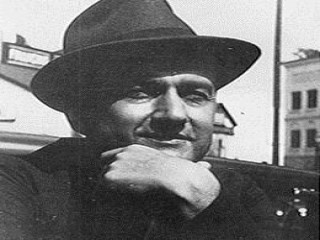
Louis Adamic biography
Date of birth : 1899-03-23
Date of death : 1951-09-04
Birthplace : Grosuplje, Slovenia, Austro-Hungarian Empire
Nationality : Slovenian
Category : Famous Figures
Last modified : 2011-05-05
Credited as : Author , and translator,
0 votes so far
He became a naturalized United States citizen in 1918. At first he worked as a manual laborer and later at a Yugoslavian daily newspaper, Narodni Glas ("The Voice of the Nation"), that was published in New York. As an American soldier he participated in combat on the Western front during the First World War. After the war he worked as a journalist and professional writer.
All of Adamic's writings are based on his labor experiences in America and his former life in Slovenia. He achieved national acclaim in America in 1934 with his book The Native's Return, which was a bestseller directed against King Alexander's regime in the Kingdom of Yugoslavia. This book gave many Americans their first real knowledge of the Balkans. It contained many insights, but proved far from infallible: Adamic predicted that America would prosper by eventually "going left", i.e. turning socialist.
He received the Guggenheim Fellowship award in 1932. During the Second World War he had supported the Yugoslav National liberation struggle and the establishment of a socialist Yugoslav federation. He founded the United Committee of South-Slavic Americans in support of Marshall Tito. From 1949 he was a corresponding member of the Slovenian Academy of Sciences and Arts.
From 1940 onwards he served as editor of the magazine Common Ground. Adamic was the author of Dynamite: The Story of Class Violence in America (1931); Laughing in the Jungle: The Autobiography of an Immigrant in America (1932); The Native's Return: An American Immigrant Visits Yugoslavia and Discovers His Old Country (1934); Grandsons: A Story of American Lives (1935, novel); Cradle of Life: The Story of One Man's Beginnings (1936, novel); The House in Antigua (1937, novel); My America (1938); Two-Way Passage (1941); My Native Land (1943); Dinner at the White House (1946); and The Eagle and the Root (1950).
Plagued by failing health, he is believed to have shot himself at his residence in Milford, New Jersey. He died at a time of political tension and intrigue in Yugoslavia, and there was press speculation in America that his death might have been an assassination by some Balkan faction, but no definitive proof of this theory has ever surfaced.
According to John McAleer's Edgar Award-winning Rex Stout: A Biography (1977), it was the influence of Adamic that led Rex Stout to make his fictional detective Nero Wolfe a native of Montenegro, in what was then Yugoslavia. Stout and Adamic were friends and frequent political allies, and Stout expressed uncertainty to McAleer about the circumstances of Adamic's death. In any case, the demise seems to have inspired Stout's 1954 novel The Black Mountain, in which Nero Wolfe returns to his homeland to hunt down the killers of an old friend.
Adamic told The Literary Digest: "My name is pronounced in this country (America) exactly as the word Adamic, pertaining to Adam": a-dam'ik. (Charles Earle Funk, What's the Name, Please?, Funk & Wagnalls, 1936.) His original surname was Adamič, pronounced in Slovenian a-DAH-mich.
Author of books:
Laughing in the Jungle (1932, nonfiction)
The Native's Return: An American Immigrant Visits Yugoslavia and Discoveres His Old Country (1934, nonfiction)
Grandsons (1935, nonfiction)
Cradle of Life (1936, nonfiction)
The House in Antigua (1937, novel)
My America (1938)
Dinner at the White House (1946)
The Eagle and the Root (1950)
















